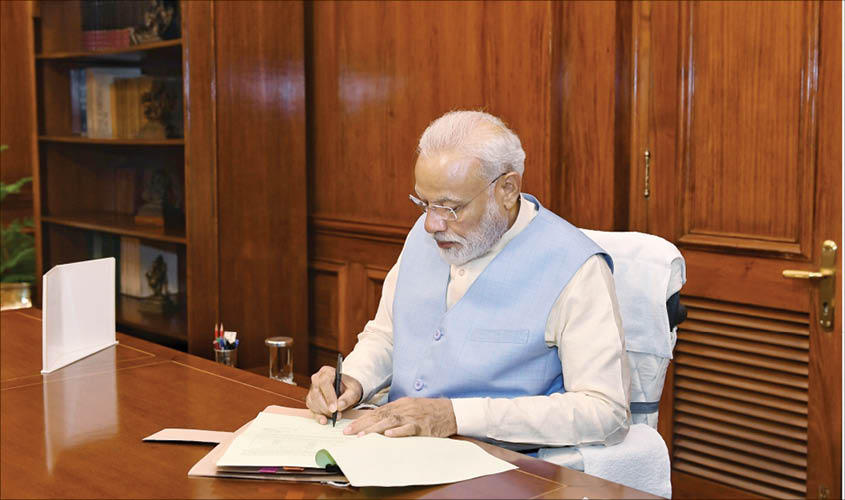Narendra Modi is perhaps destined to be the maker of India of the 21st century.
On 23 May, not the political weather but the political climate of India changed. Prime Minister Narendra Modi began his first term as a novice. He opens his second innings as a statesman. Jawaharlal Nehru was the maker of the India of the 20th century. Narendra Modi is perhaps destined to be the maker of the India of the 21st century. Narendra Modi is the third Prime Minister to serve a second consecutive term with a majority. The other two being Nehru and Indira Gandhi.
Prime Minister Narendra Modi is now in the same league as Presidents Donald Trump, Xi Jinping, Vladimir Putin, Chancellor Angela Merkel and Prime Minister Shinzo Abe of Japan. These leaders will, to a large extent, manage or mismanage the international order, international organisations, the world’s trembling economy, immigration problems and the rise of nationalism and the near abandoning of leftism minus China and Russia.
I have not included the United Kingdom for obvious reasons. Once a world power, it is now in the midst of an unprecedented political crisis, with a second rate leadership. The prospect of Boris Johnson sitting on the seat once occupied by Gladstone, Disraeli, Lloyd George, Winston Churchill and Clement Attlee is not a comforting thought.
Prime Minister Modi and his team must have worked out the priorities of Modi II. He made certain unexpected and welcome pronouncements in his nearly two-hour-long speech at the Central Hall of Parliament. His government would look for the co-operation of the Opposition in the implementation of his national development policies. Secondly, encouraging words for the concerns and doubts of the minorities. The main minority are the Muslims, numbering over fifteen crore. They need genuine assurances. Hindutva should not mean anti-Islamism. For the moment it seems so. Throughout the campaign and in his post campaign speeches not a word was said about population control. Improving the living standards of the poor—the garib—and not subscribing to birth control contradict each other rather spectacularly.
The swearing in ceremony held in the forecourt of an illuminated Rashtrapati Bhavan was impressive and very well organised. BIMSTEC leaders were present. Also the President of Kyrgyzstan.
I was immensely pleased to see S. Jaishankar included as Cabinet Minister. He was an outstanding IFS officer of the 1977 batch. He was born in September 1955. He was Joint Secretary when I was External Affairs Minister. He will make an ideal External Affairs Minister. As Foreign Secretary he was in the same league as Subimal Dutt, K.P.S. Menon and Krishna Rasgotra.
***
I was at Lords to watch India beat the West Indies in the World Cup final in the summer of 1983. From 30 May for the next six weeks countries playing cricket will be glued to their TV sets. Several non-cricket playing countries too will, at times, watch some of the matches. The World Cup was born in 1975 in London. The West Indies were the winners in 1975 and 1979. India in 1983 and 2011, Australia in 1999, 2003, 2007 and 2015.
The matches will be played at nine grounds. The Oval, founded in 1845, capacity, 25,000; Lords, 1814, capacity 28,000; Old Trafford-Manchester, capacity 24,000; Cardiff, 1854, capacity 15,200; Taunton, 1882, capacity 8,000; Bristol, 1889, capacity 11,000; Leeds, 1890, capacity 18,350; Nottingham, 1841, capacity 17,000; Chaster-le-Street, 1995, capacity 14,000; Southampton, capacity 17,000.
The ten countries participating are India, England, Australia, Pakistan, New Zealand, Sri Lanka, Bangladesh, Afghanistan, West Indies and South Africa.
The likely winners: India, England, Australia. I am putting my money on India.
***
On 29 May 1969, the Vishal Haryana Party’s young president Birendra Singh declared that Vishal Haryana should consist of Meerut and Agra divisions of Uttar Pradesh, Alwar and Jhunjhunu districts of Rajasthan, Union Territory of Delhi, the entire Kharar tehsil including Chandigarh, Hindi speaking areas contiguous to Kalka, Kandaghat, Kasuali, Nahan and Simla. Why Bharatpur was left out I was unable to comprehend. I was at the time working in Prime Minister Indira Gandhi’s office.

